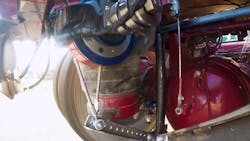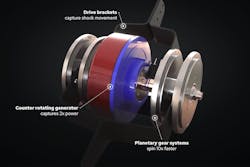Turning Road Bumps into Electricity for EVs
What you'll learn:
- Gig Performance's Roadkil 5000 that converts vibrations from the road into energy.
- BMW's technology that harvests energy introduced to a car's springs by suspension articulation due to bumps in the road
Introducing a technology game-changer is a bit like a baseball pitcher tossing a perfect game. Both events happen relatively infrequently, yet everyone knows there’s another one coming, but they’re not exactly when or by whom.
For example, as the auto industry rapidly transitions to all-electric vehicles, automakers are looking for ways to increase the range of its EVs. A clever new stratagem is to capture lost energy within the suspension system and redirect it back into the battery, dramatically increasing energy efficiency.
Two very different companies, Gig Performance and BMW, have separately found ways to harness a car's vertical wheel movement from vibrations and bumps in the road (kinetic energy) and route this energy back to the battery, where it’s stored as electrical energy.
Roadkil 5000
Gig Performance’s patent-pending suspension-based technology is called the Roadkil 5000 (the name was inspired by kilowatt, the electrical unit of measurement), which converts vibrations from the road into power, increasing efficiency for electric vehicles. The Roadkil 5000 directs energy to the electric motor and/or batteries in any vehicle—from semi truck to ATV—over any terrain to extend battery life. It provides greater performance in mileage and complements the standard EV.
Roadkil 5000 supplies energy directly to the electric motor and or batteries powering an electric truck, and in this way, extends the battery charge. It’s said to enable a 2X power boost at the same RPM. In a recent demo, SEMA attendees had the opportunity to sample the product by imitating bumps in the road with their hands to power an LED display in the company’s booth.
"The Roadkil 5000 helps keep vehicles powered, especially electric vehicles, without the need to recharge. The road beneath your wheels funnels energy to the batteries that increases your power on the move,” says Jon Woodward, Gig Performance President and Co-Founder.
"Gig Performance is going to revolutionize how we capture lost energy in vehicles across America,” added CEO Brandon Barkdull. “Our product is helping EVs charge on the go so you can stay on the road longer. Range is the biggest obstacle to EV adoption—we're excited to help solve this issue with our technology."
While the installation is different for every vehicle type, it’s said to work smoothly with each vehicle’s unique suspension system, attaching wherever it can hook in. Users also can connect as many units as there are axles.
In addition to power generation, the device functions as a dynamic shock absorbing system as well. The electrical resistance in the generator has a damping effect similar to shock absorbers. This resistance lessens the impact on a vehicle's suspension, extending the life of those parts.
Meanwhile in Munich…
A German patent office document filed by BMW, discovered and first reported by CarBuzz.com, utilizes the same untapped energy source: the energy introduced to a car's springs by suspension articulation due to bumps in the road.
Normally this energy is absorbed by the spring elements in the suspension, and then is dissipated as heat. Why? Because wheel movement can be an annoyance, and needs to be managed and smoothed out for better comfort and control.
According to the patent application, though, BMW found a way to harvest this energy instead of wasting it. The innovation involves a chassis-mounted generator unit with a small flywheel and a one-way clutch, driven by an actuating disc that, in turn, is connected to a suspension control arm via an actuator similar to a conventional stabilizer bar. When the generator’s flywheel spins, it generates electricity that can then be fed into the battery.
Carbuzz.com found the patent filed in Germany, which discusses how the system would work. When the system moves in response to a bump, a one-way clutch connected to a gear moves a flywheel attached to the generator. Once the suspension’s spring compresses the stabilizer bar, it twists in one direction, rotating an actuator disc.
When the wheel moves back down again in response to the energy stored in the spring, the actuating disc rotates along with the stabilizer arm. However, the one-way clutch engages in this direction of rotation to power a small gear mechanism, which then multiplies the speed of the suspension movement. During this process, it multiplies the torque and rotation being applied to the generator’s built-in flywheel.
The patent filing shows the generator using the kinetic energy in its flywheel to generate electricity and charge the battery. The working principle is said to be not unlike a regenerative braking system, which converts kinetic energy into electrical energy. In this case, the energy can be stored in either the car's normal 12-V electrical battery or in an EV's high-voltage traction batteries that power the traction motors, boosting the EV’s range.
BMW hasn’t revealed its plans for this system, whether it wants to integrate it into its future EVs to boost their range or offer it only as a premium feature.

